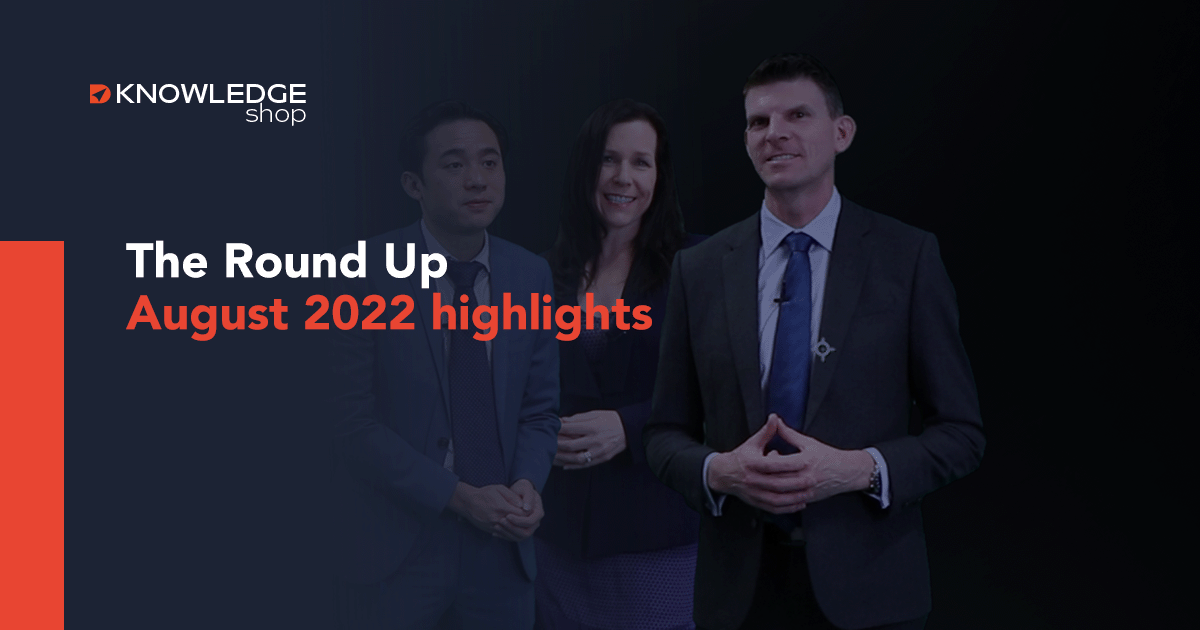Jan 2023 Round Up - the final guidance on s100A
The ATO's final position on the application of section 100A to how trusts distribute income has been released - we explore the final guidance and the court challenges to the concepts employed.
Plus, the ATO's response to the ground breaking High Court decision on the distinction between contractors and employees.
Change is a constant for the profession. The Knowledge Shop membership can help you and your team keep ahead of change with an advisers' help desk, workpaper knowledge base, quarterly PD, and more - wherever you are and however you are working. Book in a time for a tour or call the Knowledge Shop team on 1300 378 950.
Inside this month Michael Carruthers (Tax Director), Jason Hurst (Technical Superannuation Adviser), Matthew Tse (Tax Adviser) and Lisa Armstrong (MD) bring you:
Section 100A: The final position and the challenges before the courts
TR 2022/4 section 100A reimbursement agreements
Section 100A is a specific integrity provision aimed at situations where income of a trust is appointed to a beneficiary but the economic benefit of the distribution is provided to another party. When section 100A applies, the trustee is taxed on the income at penalty rates rather than the presently entitled beneficiary being assessed.
The ruling explains how section 100A operates from a technical perspective and looks at the four key elements that need to be considered in determining whether section 100A is triggered.
The following three requirements need to be satisfied in order for section 100A to apply:
- The present entitlement must relate to a reimbursement agreement;
- The agreement must provide for a benefit to be provided to a person other than the beneficiary who is presently entitled to the trust income; and
- A purpose of one or more of the parties to the agreement must be that a person would be liable to pay less income tax for a year of income.
It is then necessary to look at whether the 'ordinary dealing exception' applies. This is because the rules don’t apply if the agreement has been entered into in the course of ordinary family or commercial dealing.
The ruling discusses each of these elements in detail and includes a number of examples, particularly in relation to what is considered an ordinary family or commercial dealing. The ruling also refers to recent and ongoing cases that deal with the operation of section 100A. As these cases move their way through the courts it is possible that the ATO will need to make some amendments to the ruling to ensure that it reflects case law in this area.
PCG 2022/2 Section 100A reimbursement agreements - ATO compliance approach
In addition to the final tax ruling on section 100A, the ATO has released a final practical compliance guideline (PCG) which explains how the ATO differentiates risk and will apply compliance activities in connection with section 100A.
The PCG sets out a number of scenarios that would be considered low risk and some scenarios that would be considered high risk. The ATO also explains how it would approach this area when dealing with a situation that doesn’t specifically fall within the low risk or high risk scenarios outlined in the PCG.
A brief summary of arrangements that the ATO considers low risk include:
- The present entitlement is physically paid or applied for the beneficiary’s benefit within a two year period, although this is subject to some exclusions. For example, if the funds are physically paid to the beneficiary within two years but the beneficiary then gifts these funds to another party then this won’t necessarily be considered a low risk scenario
- The funds are paid to a joint bank account that the beneficiary holds with their spouse and the funds are used to meet household expenditure
- The funds are retained by the trustee and certain conditions are met, including that the funds are used as working capital in a business carried on by the trust and the beneficiary controls the trustee
- Arrangements that are treated as ordinary family or commercial dealings in TR 2022/4
However, the following scenarios are generally considered high risk from a section 100A perspective:
- The beneficiary is a company or trust with losses and the beneficiary is not part of the same family group as the trust making the distribution
- A beneficiary company or trust returns the funds to the trustee (i.e., circular arrangements)
- The beneficiary is issued units by the trustee of the trust (or a related trust) with the amount owed for the units being set-off against the entitlement
- Adult children are made presently entitled to income, but the funds are paid to a parent in relation to expenses incurred before the beneficiary turned 18
Practitioners who are familiar with the draft version of the PCG should carefully review the final version because there are some additional examples and the ATO has modified its approach to certain scenarios.
Two cases are currently before the courts which look at the potential application of the reimbursement agreement rules in section 100A ITAA 1997. It is worth noting that while the Commissioner's appeal did not succeed FC of T v Guardian AIT Pty Ltd ATF Australian Investment Trust; FC of T v Springer [2023] FCAFC 3 in relation to section 100A, the Full Federal Court found that Part IVA did apply.
The important reminder here is that general anti-avoidance provisions such as Part IVA can potentially apply, even if specific integrity provisions don’t apply to a particular arrangement. Practitioners need to be especially careful when considering arrangements that involve the insertion of additional steps that don’t seek to serve any commercial or non-tax purpose.
The December CPI rate impact on superannuation and retirement income streams
Following the release of the December 2022 CPI figures, the general transfer balance cap (TBC) will increase from $1,700,000 to $1,900,000 from 1 July 2023. This could provide tax effective retirement pension and non-concessional contribution opportunities for some of your clients.
Individuals who commence a retirement phase income stream for the first time after 1 July 2023 will have access to the full $1,900,000 limit. For some individuals there may be a benefit in deferring the commencement of a retirement income stream until on or after 1 July 2023.
Where the complexity lies with the transfer balance system is that clients who have commenced a retirement phase income stream before 1 July 2023 will have a personal TBC that is different to the general TBC. This is due to the fact that indexation only applies to the individuals unused TBC. Based on the proportional indexation rules we face a situation where a client could have a personal TBC anywhere between $1,600,000 and $1,900,000. Your client’s personal TBC and eligibility for indexation is shown on the ATO Portal and under their My Gov Login so this should be checked before commuting or commencing any retirement phase pensions.
The Average Weekly Earnings statistics that determine indexation of the superannuation contribution caps will be released on 23 February 2023. We will bring you the latest updates after the release.
The ATO's response to the High Court's decision on the employee vs contractor distinction
Following some recent and prominent High Court decisions in this area, the ATO has released a draft ruling which explains how to determine whether a worker should be classified as an employee for PAYG withholding purposes. The ruling focuses on determining whether someone is an employee under the ordinary meaning of the term but doesn’t look at the extended definition of employee that is used in the context of the superannuation guarantee system.
The ATO emphasises that whether an individual is an employee is a question of fact to be determined based on an assessment of the entire relationship between the parties. If the worker and engaging entity have committed the terms of the relationship into a written contract then the analysis needs to be performed with reference to the legal rights and obligations in the contract. That is, the key focus is on the terms of the contract rather than the subsequent conduct of the parties.
The label used by the parties to describe the relationship is not determinative of the classification. Labels which are inconsistent with the rights and obligations under the contract should be ignored when classifying the worker.
In determining whether a worker should be classified as an employee there are a range of factors that need to be considered. The ATO indicates that the key distinction between an employee and an independent contractor is that:
- An employee serves in the business of an employer, performing their work as a representative of that business.
- An independent contractor provides services to a principal's business, but the contractor does so in furthering their own business enterprise; they carry out the work as principal of their own business, not a representative of another.
In addition to looking at whether the worker is serving in the engaging entity’s business, it is important to consider the extent to which the business can control how, where and when the workers perform their work.
Aside from these two key factors there are a number of other indicia that could be relevant in classifying the worker, including:
- The ability to delegate work;
- Whether the contract is on a results basis;
- Which party provides the tools and equipment;
- Risk; and
- Generation of goodwill.
In the draft ruling the ATO states that where a worker engages to perform work for a business as a partner of a partnership or through a company or trust then this may indicate an intention by all parties not to create an employment relationship. However, a different conclusion may be reached if a worker uses an interposed entity but is also directly a party to the contract with the engaging entity.
In addition to the updated draft tax ruling the ATO has issued a draft PCG which explains how the ATO will allocate compliance resources in connection with the classification of a worker as an employee or independent contractor.
The PCG starts by outlining some of the consequences of a worker’s classification. This is a brief but useful checklist for both engaging entities and workers.
The draft PCG then outlines the risk framework that will be used by the ATO for worker classification issues, based on the actions taken by the parties when entering into the arrangement. It is important to recognise that the draft PCG does not extend to employment law issues, state based issues or the income tax affairs of the worker (e.g., whether they are subject to the PSI rules etc).
The PCG sets out four risk categories, which are based on a number of factors, including:
- Whether there is evidence to show that the parties have agreed on the classification;
- Whether there is evidence that the parties understand the consequences of the classification;
- Whether the performance of the arrangement has deviated significantly from the terms of the contract;
- Whether the party seeking to rely on the PCG has obtained specific advice confirming that the classification is correct; and
- Whether the party seeking to rely on the PCG is meeting various tax, superannuation and reporting obligations.
The impending crackdown on the sharing economy and what you should be telling clients
Treasury Laws Amendment (2022 Measures No. 2) Bill 2022, which received Royal Assent on 12 December 2022, contains amendments that will require sharing economy platform providers to provide information on transactions undertaken on the platform to the ATO. Broadly, this amendment involves expanding the taxable payments reporting system (TPRS) to apply to certain transactions made through an electronic platform.
The reporting rules apply to taxi services (including ride sourcing) and short-term accommodation from 1 July 2023. The rules commence from 1 July 2024 for all other reportable transactions.
Clearly, the Government is concerned that payments through the sharing economy are not being appropriately disclosed for tax purposes and are keen to close the gap. The date collected from the new reporting regimes will provide the ammunition to do exactly that. Ensure your clients know what their obligations are and the impending crackdown.
Enjoy!
Share this
You May Also Like
These Related Stories

September 2024 Round Up - Payday Super: The first details

August 2022 Round Up - The investment 'boosts' explained


No Comments Yet
Let us know what you think